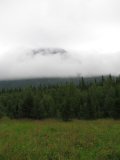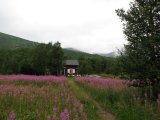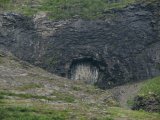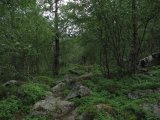Monday 13/8

Bobäcken – Tarrekaise
| Horizontal distance: | 18.5 km |
| Vertical distance: | +260 m, -40 m |
| Time: | 6 h |
| Lunch break: | 1 h 15 min |
| Dinner: | Chicken and pasta |
| Night accommodation: | Cottage |
| Stage classification: | Easy |
| Map points: | Bobäcken, Njunjes, Tarrekaise |
Having woken up at 07:45 I found the clouds to be pretty low still, but there was neither rain nor wind and the temperature was well on the mild side. After breakfast I took my time packing up, having a good margin to the 09:30 boat to Bobäcken and Padjelantaleden (Padjelanta Trail). It was difficult making any kind of prediction regarding the weather, but I had chosen to wear the rain trousers to protect against the conceivably wet undergrowth that was to be found along the start of the trail last time around. As it turned out I was the only passenger in the boat – there had been quite a few people about to depart from the station, but it seemed as though they were all headed for the bus which was just pulling in.
The boat driver was the same as last time too, and to his credit he recognized me straight away. Not far upstream Darrhaädno we turned off into the channel that comes from Mierdekjávrre on the northern side to make a note of the water level, and since there is no other outflow we had to take the same way back out to Darrhaädno proper. Having reached the jetty at Bobäcken we spoke for a while about my coming assignment and the state of the area in general, and we also came to an understanding about how the return journey would be handled.
I started walking after 10, and quickly it was clear that the dampness I had expected was far less pronounced than feared – the trail had obviously been trimmed since my previous visit, so there was much less vegetation flanking the path in the first place. I met two people before the large suspension bridge over Vállebäcken, at the other side of which I exchanged the rain trousers for the regular ones and removed the wind jacket; it was getting rather warm and as I remembered things there would be no more dense vegetation before the Njunjes settlement. As mentioned it wasn't that wet to start with either, and it was my judgment that there was to be no rain in the foreseeable future.
I had now fallen into my usual stride, and the kilometers passed one by one. I encountered a total of 11 people, most in groups of two and all of them heading towards Kvikkjokk. As I progressed in the opposite direction the clouds slowly lifted ahead of me, and behind me the sky was growing lighter as well. The air was warm and humid but going was easy, even though I was beginning to feel a tiny hint of the Achilles tendon ache that had plagued me during the final stages of the recent Sarek tour; I was also beginning to notice that the pack was a bit heavier than it thitherto had been. These were still very mild complaints, however, and without further ado I found myself at Njunjes, the residents of which were present. The "jungle portion" that follows was also much less obtrusive compared to last year, what with the height of summer being in the past – this time I could actually see the path! – although quite a few species of plants were still in bloom. As I was approaching the Njunjes cottage at 12:45 a light wind alleviated the warmth, which was now somewhat pressing.
Ulla the warden was just finishing up the more or less weekly cleaning procedure, and we talked while I had lunch on the porch. There was no one else there, but there was a tent complete with occupants on the other side of the river, which is spanned by a bridge in the immediate vicinity. During our continued conversation the sky lightened further and the clouds lifted some more, especially in the upwards-Tarradalen direction. I was in no particular hurry and had made good speed thus far, so I saw no reason not to relax for a while longer before putting my burden back on.
Going up the outrunner above Njoammelgårttje was a warm affair even though there was still no sun save for a few glimpses on the wall of Darregájsse directly to the north; over this massif some patches of blue had appeared in the cloud cover, but off to the east it was fully overcast. Both the plateau and the downward slope on the other side were stonier than I remembered, and my added weight probably made it stand out more now. At the western crest a pleasant breeze cooled me off, but once into the forest again its effect was not much to speak of. After the meadows beneath the peculiar Basseuksa niche I met a quartet of young men, and then it was back to stones – this particular portion of this particular stage is likely the cause that people often raise a warning finger about it, but it really isn't that extensive. I came upon a small tent wedged between the trees beside a small brook shortly before the Tarrekaise cottages, which suddenly jumped out of the dense forest at 16:00.
I was greeted by one of the two wardens in the main cottage, which already held a group of six ladies from Åland. Having installed myself I then answered the invitation to join the warden pair (Ove and Berit) in their cottage, where I was treated with some newly baked bread and cake, and we spent a long time discussing wardenship and "fjelding". I was also given a sizeable letter containing inventory lists and the like I would be needing later on. All of this was finally interrupted when a pair of German campers arrived, so I took my leave and went down to the shore of Darrávrre to have a look; the clouds had descended again and the humid warmth persisted. Since it was now early evening I returned to the other cottage to change clothes and prepare dinner, soon being joined by the Germans.
The cloud base continued to drop, and eventually a few drops of rain started falling. The Germans were now departing, leaving me alone in "my" half of the building, and I took to playing solitaire and reading in the old guestbook. The falling drops soon turned into actual rain, during which parts of Soahkevárre could be seen across the lake every now and then. Later in the evening the rain stopped, and another pair of Germans came in from the west and took a short break before pressing on; they met another two just at the edge of the field, and they all went off together.
As I was having a light snack a Swedish couple arrived from the east, having taken the 13:30 boat from Kvikkjokk, and the subsequent walk had left them somewhat worn. It was their intention to stay on Nordkalottleden to Pieskehaure and then follow the continuation of this trail northwards to Staddajåkkå and Stáloluokta – in other words something very much like what I had done last summer, only sticking to the marked trail. They were a bit concerned about the state of any and all fords along the way, and on the Pieskehaure–Staddajåkkå stage there is one of appreciable size, namely that of Hádditjåhkå. Since I had broken off towards Hádditjávrre and Råvejávrre when I passed that way I had no first-hand information about it, but I estimated its difficulty level as well I could with the available data (resulting in a calming statement rather than a warning). Outside there was a light drizzle and dense low clouds, and inside I turned in for the night around 21:30 while the other two had a late evening meal.






































